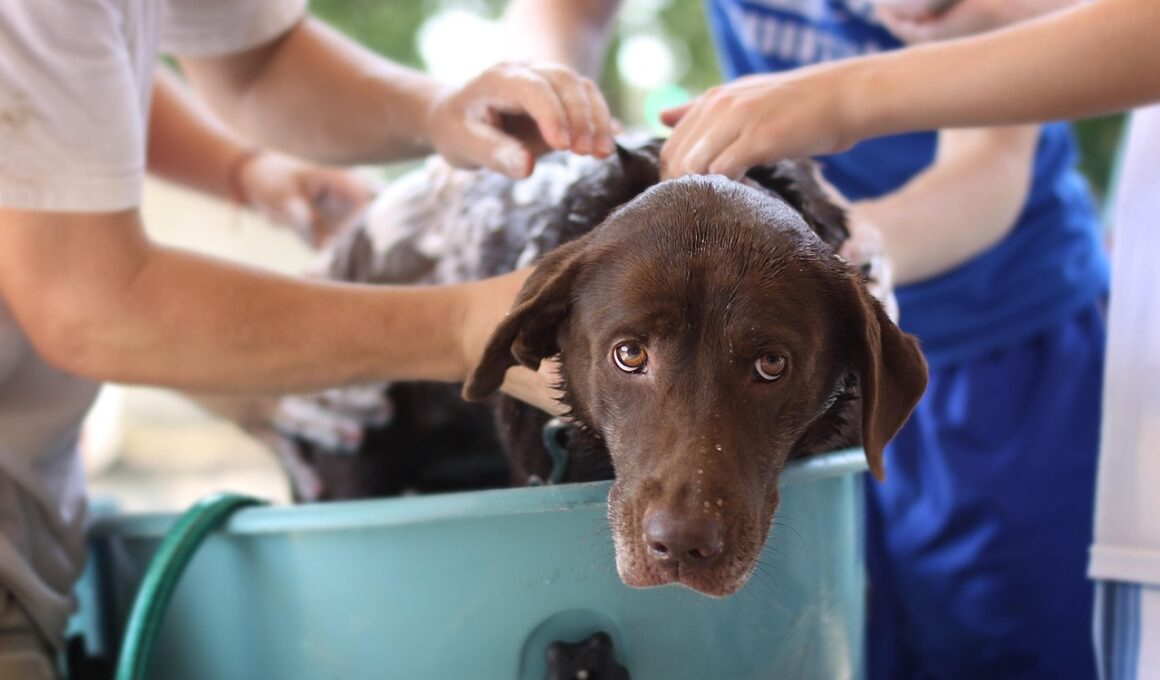Preventing Hot Spots in Dogs During Summer
Summer brings beautiful weather but also presents challenges for our beloved dogs, particularly concerning skin conditions like hot spots. Hot spots, also known as acute moist dermatitis, occur when a dog persists in irritating a specific area on its body. These hotspots are often triggered by heat, humidity, and excessive moisture. To prevent hot spots, the first step is to ensure your dog’s coat is kept clean and dry. Regular grooming sessions to remove excess hair and debris can also help maintain skin health. Pay special attention to areas prone to matting, as mats can trap moisture and worsen the situation. A well-groomed dog not only looks better but can enjoy summer activities without discomfort. Additionally, if your dog loves swimming, make sure to dry them thoroughly after each dip. This practice minimizes bacterial growth and helps prevent hot spots. Consider using a mild, dog-friendly shampoo during baths to further promote skin health. If your dog has a thick coat, brushing them multiple times a week can drastically reduce the likelihood of matted fur caused by heat and moisture. Overall, observing these habits will promote a happier, healthier dog in summer.
Additionally, observing your dog’s behavior during hot summer months plays a crucial role in hot spot prevention. Dogs often lick or scratch at their skin when they are uncomfortable or itchy, and this behavior can lead to hot spots. If you notice your dog excessively grooming themselves, it could signal underlying issues like skin allergies or infections. A visit to the veterinarian for an evaluation is advisable in such cases. Identifying the source of discomfort, such as allergens in their environment, can help you avoid heat-related skin issues. Maintaining a cool and comfortable environment is also essential. Ensure ample access to shade and fresh water during the hot hours of the day. Keeping your home cool with fans or air conditioning can provide relief while also aiding in preventing skin aggravation. Proper hydration is vital for your dog’s overall health, so encourage regular water intake to ensure they remain refreshed. Moreover, consider moderating exercise during peak heat times. Opt for early morning or late evening walks when temperatures are cooler, reducing the risk of heat-related skin problems. This approach promotes a pleasant experience for your pet even in the heat of summer.
Importance of Diet in Skin Health
The role of diet in your dog’s skin health cannot be overstated. A balanced diet rich in Omega fatty acids contributes significantly to maintaining a healthy coat and skin. Consider incorporating fish oils or supplements specifically designed to enhance skin quality. Foods with high-quality proteins and natural ingredients will promote overall well-being. Ensure that your dog’s diet contains essential nutrients that bolster skin health, such as vitamins E and A. These vitamins work together, improving skin elasticity and resistance against infections. If you suspect that food allergies are a problem, consult your veterinarian for guidance on appropriate dietary changes. Switching to a hypoallergenic dog food may be necessary if you notice skin irritations that might relate to their diet. Regularly monitor your dog’s weight and make adjustments to their caloric intake based on their activity level, as overweight dogs may face additional risks during the summer. Remember that your dog’s skin can reflect their internal health, meaning that providing quality nutrition can impact skin conditions like hot spots profoundly. Dietary adjustments are often a crucial part of a comprehensive strategy to prevent hot spots.
Another vital aspect of preventing hot spots is ensuring your dog is free from parasites. Fleas and ticks can cause irritation and lead to excessive scratching and biting, creating an environment conducive to hot spots. Regularly check your dog for these parasites, particularly after outdoor activities. Utilizing veterinarian-recommended preventive treatments can drastically reduce these risks. Ensuring that your yard is kept clean and well-maintained can also assist in minimizing exposure to parasites as well. Additionally, keep your dog’s living area tidy by washing bedding frequently and using flea treatment if necessary. Recognize that while outdoor activities are enjoyable, they also increase the likelihood of encounters with other animals that may carry fleas. By being proactive in maintaining your dog’s environment, you can create a safe and healthy space that reflects positively on their skin health and overall well-being. With the right preventative care and treatment, you can ensure that your furry companion enjoys the summer without unpleasant skin conditions. Thus, maintaining proper care for your dog is essential in keeping hot spots at bay, ensuring they remain playful throughout the summer.
When to Seek Professional Help
Despite your best efforts, there may be times when a hot spot does develop. Identifying and addressing them early is vital to preventing further complications. Symptoms to look out for include redness, swelling, or discharge in localized areas of your dog’s skin. Persistent scratching or licking of these areas, leading to hair loss, necessitates a veterinarian’s assessment. Timely intervention can prevent the hot spot from becoming more extensive and uncomfortable for your dog. Your veterinarian may recommend topical treatments or, in severe cases, prescribe antibiotics to address secondary infections. Additionally, professional grooming following a hot spot incident aids in overall recovery by ensuring the affected area is sanitized and diminish the chances of reoccurrence. Follow all aftercare instructions to ensure proper healing, allowing your dog to return to their usual activities with minimal discomfort. Always err on the side of caution; even minor irritations might progress into severe problems without careful attention. Taking your dog for regular health check-ups can also provide peace of mind and help catch potential issues before they develop into significant concerns.
Lastly, keeping a keen eye on your dog’s behavior, health, and grooming needs can significantly prevent hot spots throughout the summer months. Approach your dog grooming routine as a bonding experience rather than merely a chore. Introduce your dog to grooming tools gradually, and use positive reinforcement techniques to make the experience pleasant. Short, frequent grooming sessions can be less stressful than long marathons, leading to a happier dog. You can set aside a few minutes daily to brush your dog, checking for any skin issues while doing so. Don’t hesitate to include your dog in other summer activities, ensuring they enjoy the warmer months while maintaining their grooming routine. Encourage hydration breaks during play to help keep their skin hydrated externally. By combining these fun activities with grooming practices, your dog will be more adaptable and willing to indulge in routine maintenance. Your efforts will cultivate a healthier lifestyle that ultimately reduces the occurrence of hot spots. Keeping your dog’s coat healthy during the summer will create a wealth of benefits, including a more enjoyable summer.
Conclusion
In conclusion, taking proactive measures in grooming, diet, environment, and health care creates a holistic approach to preventing hot spots in dogs. The warm months should be enjoyable for both you and your four-legged friend, fostering a lively and healthy partnership. Hot spots should never become a barrier to outdoor fun, as routine practices can considerably reduce their likelihood. Just as you enjoy summer activities, your canine companion deserves to experience those same joys. By implementing the strategies presented in this guide, you can help your dog avoid discomfort, while allowing them to embrace the sunny months with enthusiasm. Maintain regular check-ups with your veterinarian to adapt any necessary routines and monitor their skin health effectively. Be attentive to changes in behavior and grooming needs, and act promptly if issues arise. Overall, prioritizing your dog’s skin health alongside their overall well-being ensures a balanced and fulfilling life. Enjoy the summer to the fullest while caring for your pet’s needs, creating a harmonious experience worth remembering. With the right knowledge and practices, you can foster a happier and healthier dog throughout the season.
Remember, your dog relies on you for consistent care, understanding, and comfort. With diligence and patience, it’s possible to prevent hot spots and ensure your pup remains at their best during summer. Implementing these tips fosters a loving owner-dog relationship and enhances their quality of life. By taking small steps now, you enhance your dog’s comfort in the long term. Focus on quality time spent together, and keep your environment safe and healthy for them. This proactive approach not only guarantees comfort but shows your love and commitment to your pet’s well-being. Engage in frequent observations of your dog, ensuring that everything is running smoothly, and that they are not showing signs of distress. Ultimately, preventing hot spots during summer is about forming beneficial habits that extend beyond the season. When you combine love and attentiveness with effective grooming and health management practices, your dog’s life quality will flourish irrespective of the time of year. Achieve that desirable summer experience for your dog, meaning happiness and health can coexist seamlessly.


